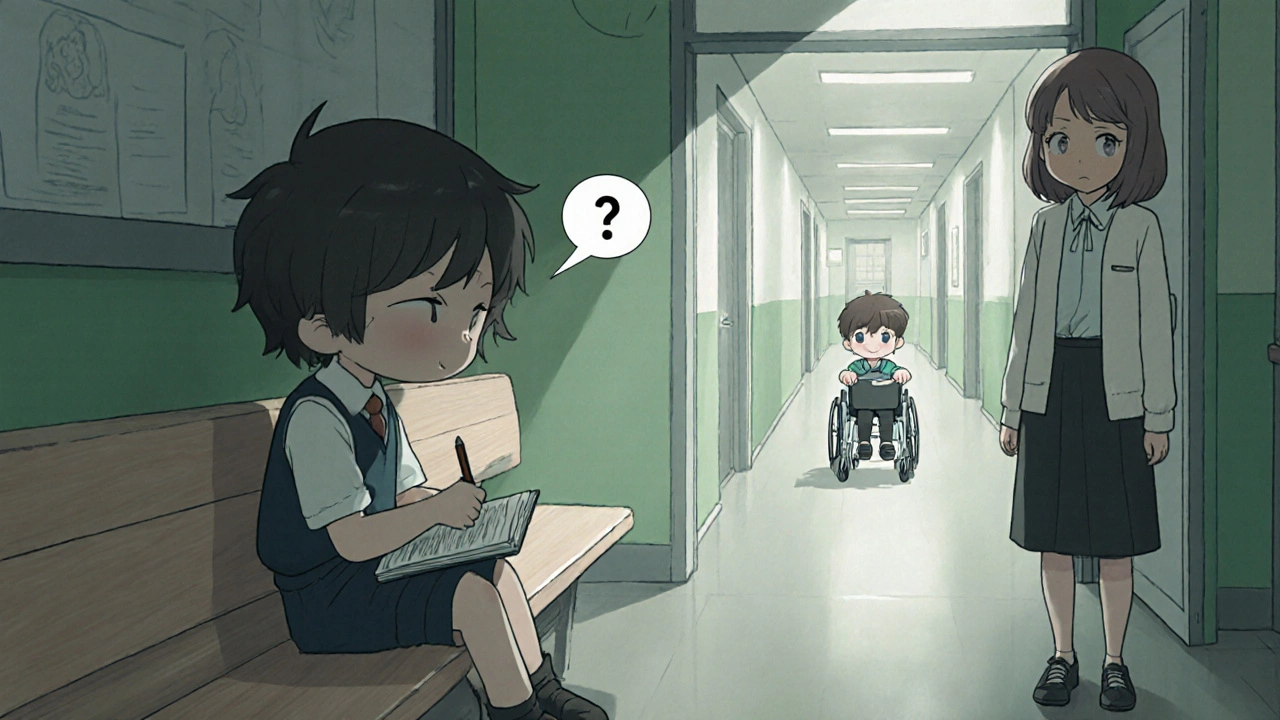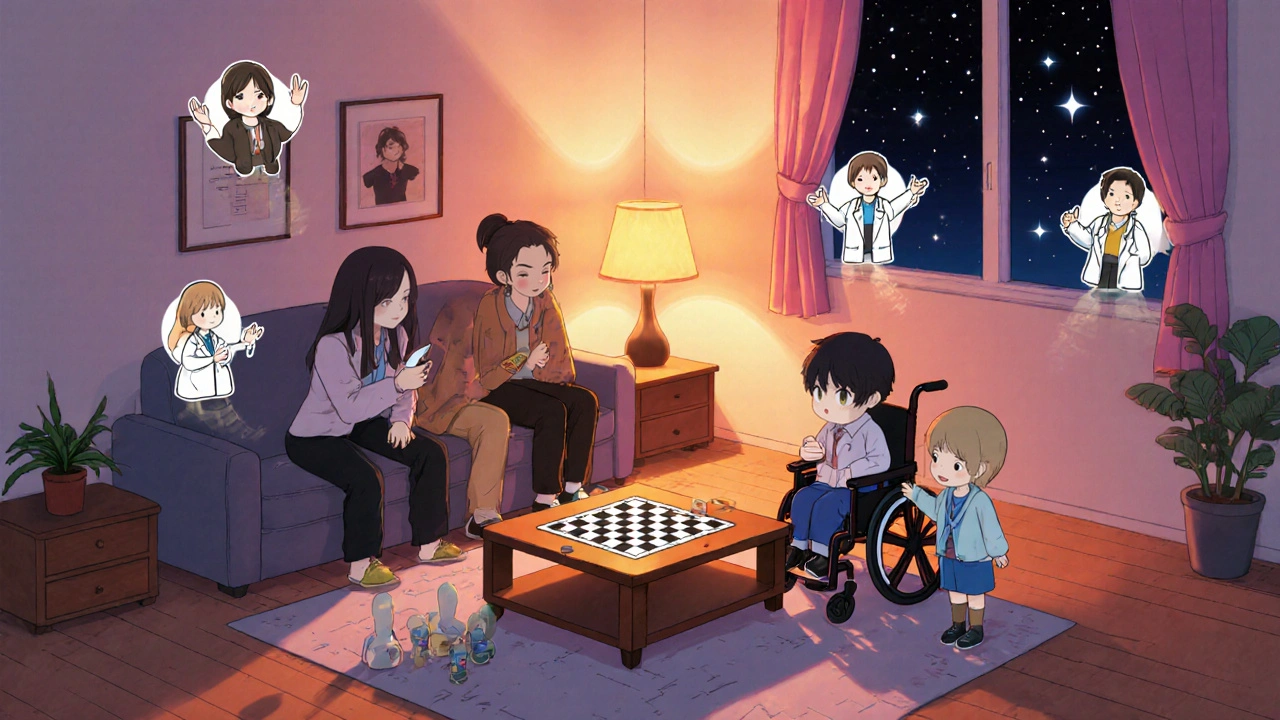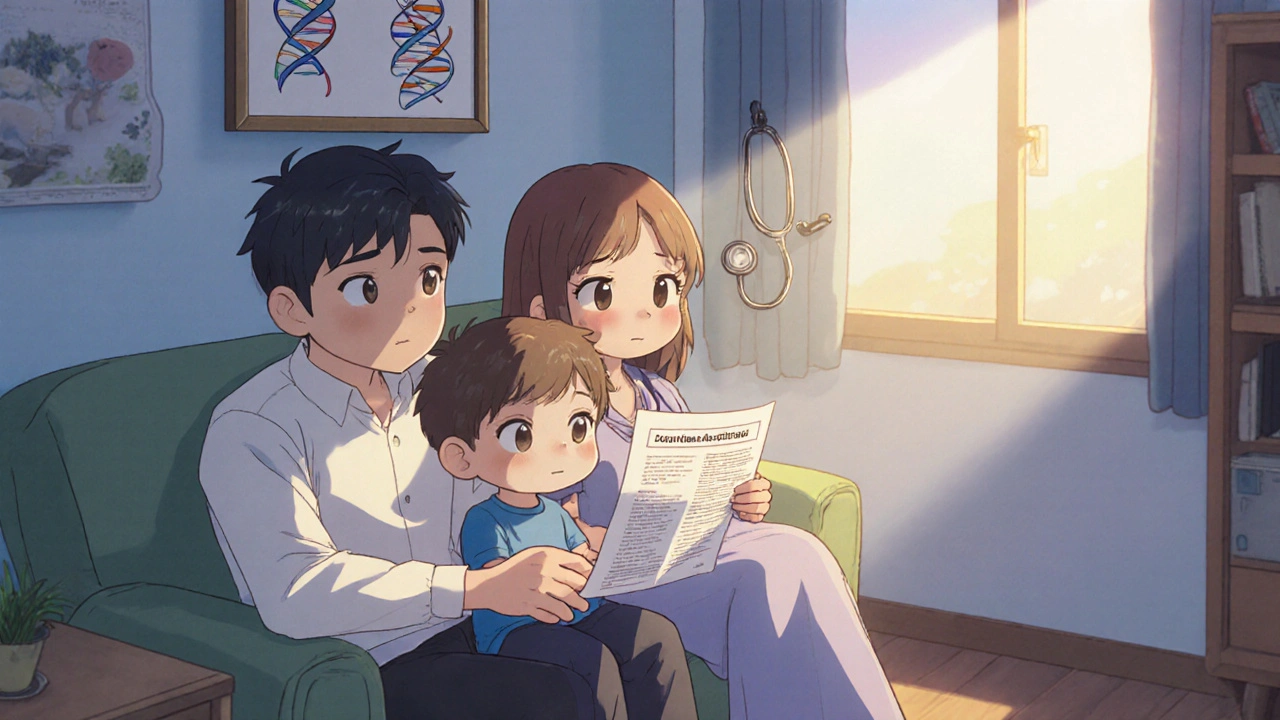When a child receives a diagnosis of Duchenne Muscular Dystrophy is a progressive, X‑linked muscle‑wasting disease that typically appears before age five, the ripple effect reaches every corner of the household. Understanding the challenges of Duchenne Muscular Dystrophy on families is the first step toward healthier coping.
What Families Need to Know About Duchenne Muscular Dystrophy
Duchenne Muscular Dystrophy is caused by mutations in the dystrophin gene, leading to rapid loss of muscle strength and function. Boys are affected almost exclusively, and life expectancy has improved to the mid‑30s thanks to multidisciplinary care. While the medical journey dominates clinic visits, the emotional terrain for parents, caregivers, and especially siblings often stays hidden.
The Sibling Experience
Sibling refers to the brother or sister who shares the family home with a child diagnosed with DMD. Their world changes overnight. Common feelings include:
- Guilt: Wondering if they somehow caused the condition.
- Neglect: Perceiving that parents' attention is monopolized by medical appointments.
- Identity shift: Becoming the “healthy” child, which can feel both relieving and burdensome.
Research from the Muscular Dystrophy Association (2023) showed that 68 % of siblings report increased anxiety during the first two years after diagnosis. In real life, I’ve seen a 12‑year‑old ask, “Why does Mom have to stay at the hospital while I’m at school?” That question signals a need for open dialogue.
Parents and Caregivers: Balancing Roles
Parent is the mother, father, or legal guardian responsible for the child’s wellbeing. and Caregiver includes any family member or professional who assists with daily care tasks. often wear two hats: medical advocate and emotional anchor. The hours spent on physiotherapy, medication scheduling, and therapy appointments can squeeze out family meals, bedtime stories, and spontaneous play.
One practical tip: set a weekly “family hour” where the focus shifts from medical tasks to simple enjoyment-board games, a walk, or a shared movie night. This routine signals to siblings that they remain a priority.

How Family Dynamics Shift
The term Family Dynamics describes the patterns of interaction, communication, and roles within a family unit. evolves in three noticeable ways:
- Communication patterns become more medical‑focused. Conversations about school or hobbies may be interrupted by updates on breathing equipment or therapy appointments.
- Decision‑making concentrates on the child with DMD, often leaving siblings feeling sidelined during major choices such as relocation or vacation plans.
- Emotional climate can swing between resilience and burnout. Parents may unintentionally project stress, which children pick up as tension.
Addressing these shifts requires conscious effort: schedule regular family check‑ins, give every child a chance to voice concerns, and celebrate small victories together.
Professional Support: Who Can Help?
Managing the medical side is only half the battle. A multidisciplinary team can smooth the psychosocial ride:
- Pediatric Neurologist specializes in diagnosing and treating neurological conditions in children, including DMD.
- Physical Therapist designs exercises to preserve muscle strength and prevent contractures.
- Psychosocial Support covers counseling, peer groups, and mental‑health services for the whole family.
- Genetic Counseling offers families information about inheritance patterns, carrier testing, and family planning.
- School Counselor helps integrate the child’s medical needs into the school environment and supports siblings’ academic well‑being.
- Support Group provides a safe space for families to share experiences, resources, and coping strategies.
When these experts collaborate, families report a 40 % reduction in perceived stress (National DMD Registry, 2024).
Practical Strategies Families Use Every Day
Below is a quick‑reference table that pairs common challenges with realistic actions. It’s designed to fit on a kitchen fridge or a phone note.
| Challenge | Typical Impact | Suggested Support |
|---|---|---|
| Sibling feelings of neglect | Increased anxiety, acting out at school | Weekly one‑on‑one time with parents; involve siblings in therapy activities |
| Parent burnout | Fatigue, reduced patience | Respite care services; caregiver support groups |
| Medical‑appointment overload | Missed work, disrupted routines | Centralized appointment calendar; telehealth for routine check‑ins |
| School integration issues | Absences, social isolation | Individualized Education Plan (IEP); school nurse liaison |
| Uncertainty about the future | Family tension, fear | Genetic counseling; family‑focused therapy sessions |

Key Takeaways
- The diagnosis of Duchenne Muscular Dystrophy reshapes every family member’s emotional landscape.
- Siblings often grapple with guilt, neglect, and a shifting identity; intentional communication can ease these feelings.
- Parents and caregivers benefit from scheduled “family‑only” time and from accessing respite services.
- A multidisciplinary team-including neurologists, therapists, counselors, and school staff-creates a safety net that reduces stress for the whole household.
- Simple, consistent strategies-like the challenge‑impact‑support table-turn overwhelming moments into manageable steps.
Resources & Next Steps
If you’re looking for concrete help, start with these trusted sources:
- Muscular Dystrophy Association (MDA) - offers local support groups and financial assistance guides.
- National Institute of Neurological Disorders and Stroke (NINDS) - provides up‑to‑date research summaries.
- Contact your regional Genetic Counseling clinic for carrier testing and family‑planning advice.
- Ask your child’s Pediatric Neurologist about referral to a child‑focused psychologist.
Take one small action today-whether it’s a 15‑minute chat with your sibling or a phone call to a local support group. Tiny steps add up to a healthier family life.
Frequently Asked Questions
How can I talk to my healthy child about DMD without causing fear?
Use simple language, answer only what they ask, and focus on strengths. Emphasize that you’re all a team and that help is available. Keep the tone hopeful rather than frightening.
What signs suggest a sibling is feeling overwhelmed?
Changes in sleep patterns, sudden irritability, dropping grades, or withdrawing from friends often signal hidden stress. Early monitoring lets you intervene before problems snowball.
Are there financial assistance programs for families caring for a child with DMD?
Yes. Both the MDA and local NHS charities provide grants for equipment, home modifications, and respite care. Check eligibility criteria on their websites or ask your hospital social worker.
Can schools accommodate a child with DMD while still supporting siblings?
Schools can create an Individualized Education Plan (IEP) that outlines needed physical accommodations and also provides counseling time for siblings. Collaboration with the school counselor is key.
What long‑term coping strategies work best for families?
Maintain regular family rituals, engage in joint activities that don’t revolve around medical care, and schedule periodic family therapy sessions. Consistency builds resilience over time.

9 Comments
Ritik Chaurasia
In Indian families, the concept of duty is woven into every heartbeat, so when a child is diagnosed with DMD the whole clan feels the weight. The siblings often shoulder invisible guilt, wondering if their very existence somehow caused the tragedy. Parents plunge into a marathon of hospital visits, leaving the “healthy” child battling loneliness and resentment. This cultural pressure amplifies the need for a deliberate family hour where every child, not just the patient, receives undivided attention.
Gary Marks
Man, reading this post made me feel like I’ve been dragged through a swamp of relentless sorrow and yet there’s this flicker of hope that refuses to die out, and it’s maddening how the system spits out bullet points about “weekly family hour” while families are still scrambling for the next insurance approval, and the siblings? They’re stuck in a vortex of guilt, neglect, and identity crisis, forced to be the poster child for resilience while secretly yearning for a normal childhood, and trust me, that double‑life is a nightmare that no child should endure, especially when the parents are juggling physiotherapy schedules that look like military operations, and the doctors keep dropping jargon like that’s supposed to be comforting, but it just adds another layer of confusion, and don’t even get me started on the financial burden, because every piece of equipment costs an arm and a leg, and the emotional toll? It’s a silent scream echoing through hallway walls that no one truly hears, and yet the article suggests simple solutions like board games, which feels like putting a Band-Aid on a broken limb, but maybe, just maybe, those moments of shared laughter can stitch something together, and I’m sick of the polite optimism that ignores the raw, ugly reality of caregiver burnout, and the fact that support groups are often buried under endless paperwork, making them inaccessible to those who need them most, and you have to wonder why a society that prides itself on medical advancement still leaves families to fend for themselves in a sea of paperwork and endless appointments, and the only thing that could truly help is a seismic shift in how we allocate resources, not just a cute table on a fridge, and if anyone reading this thinks a single family hour will cure the deep‑seated anguish, you’re tragically naïve, and that’s why I’m yelling from the rooftops: we need systemic change, not just suggestions, and if we don’t get it, we’ll keep watching families crumble under the weight of an unforgiving disease.
Vandermolen Willis
😊 Wow, this really hits home. Siblings can feel so left out, but a quick 15‑minute chat after school can make a world of difference. It’s amazing how a simple board game night can remind everyone they’re still a team. Keep the love flowing, and don’t forget to celebrate the tiny victories – they add up! 💪
Steven Young
They’re hiding the real cause of the stress they say it’s just medical paperwork.
Sireesh Kumar
Listen up, folks, because I’m about to drop some hard‑earned knowledge on you. The sibling experience isn’t just a side‑note; it’s a full‑blown drama that can eclipse the patient’s storyline. Imagine being the ‘healthy’ kid while the world spins around hospital corridors and the constant beeping of monitors. The guilt is like a phantom that follows you to school, whispering that you’re somehow responsible for the genetic twist that landed your brother or sister in that battle. And then there’s the neglect vibe – parents are forced to split their attention like a magician pulling rabbits out of hats, leaving the rest of the family to fend for themselves. In Indian households, where extended family is the norm, the pressure intensifies because everyone expects you to carry the emotional torch. The identity shift is brutal; you become the unofficial spokesperson for the family, the caretaker in training, and the one who must pretend everything’s fine while inside you’re screaming. One practical hack? Set up a ‘sibling spotlight’ night once a month where the healthy child gets to lead an activity they love – whether it’s video games, painting, or a backyard soccer match – and the whole family participates. It’s a direct counter to the guilt and neglect narrative. Also, don’t underestimate the power of a simple “I see you” note left on the fridge; it can validate feelings that are otherwise drowned out by the rush of appointments. Finally, remember that professional help isn’t just for the patient – family counseling can dissect these shifting dynamics and give each member the tools to cope. Trust me, when the invisible burdens are lifted, the whole family breathes easier.
Jonathan Harmeling
It’s about time we stop treating the sibling’s pain as an afterthought and start holding families accountable for the emotional damage they endure – the moral compass of our healthcare system should point toward holistic care, not just treating the obvious symptoms.
Mary Keenan
This article is overly simplistic.
Kelly Brammer
While brevity is appreciated, reducing complex familial dynamics to a single sentence overlooks the profound ethical responsibility we have to nurture every member of the family with compassion and respect.
Denver Bright
Hey, can anyone tell me how they manage to keep their own sanity while juggling all this? I mean, we’re all in the same boat, right?